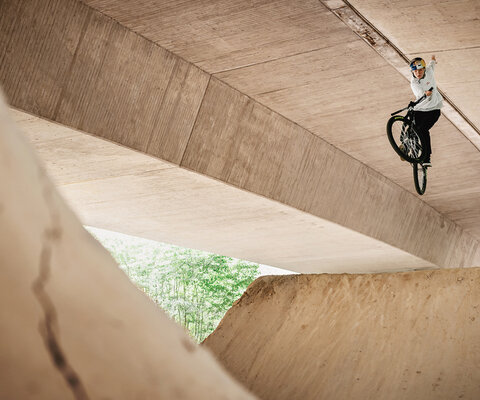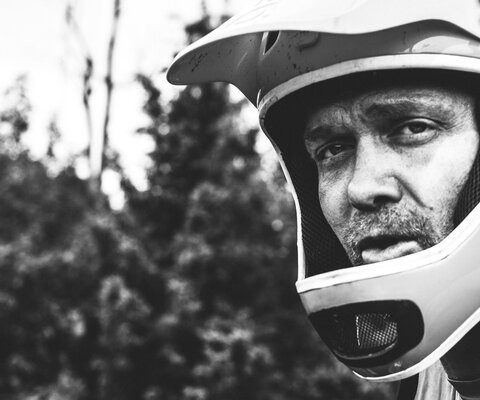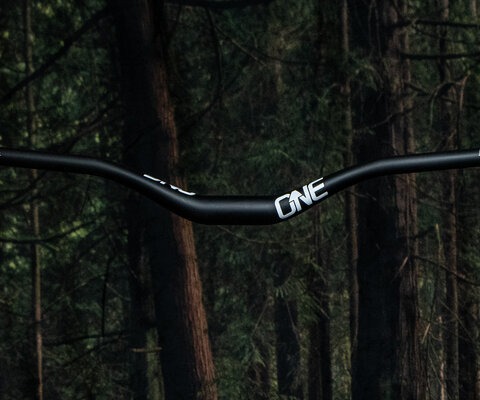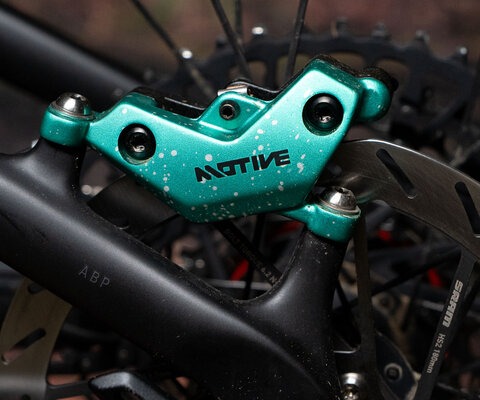
A Backyard Frontier - The Shenandoah Valley, Virginia's Worst-Kept Secret
It’s not apparent that the tow-behind bike trailer will really fit in the darkness between the trees, but Chris Scott goes for it anyway.
From the floor in the back of his Ford Expedition, Jeremy Wimpey calls out the distance, directing Scott through a four-point turn that would take most drivers quadruple that. The trailer does fit, it turns out, and soon we’re bouncing down Tilman Road in Virginia’s George Washington National Forest.
It’s been a long day of riding and we’re beat and hungry. Tim Haren, one of our group of North Carolinians, asks if the local grocery store—colorfully called “the Market”—is open. Scott calls when we reach cell service, and finds out they’ve got enough dough for two pizzas. Good enough for us. Scott gases the SUV down the now-pavement road.
We’re in Stokesville, VA, once a thriving railroad community. Now the only structures remaining are a few houses, the Market, the railroad depot, a church built in 1903, and a single trestle. Inside the Market is what one expects from a dilapidated cinderblock building deep in the middle of what feels like nowhere: fishing tackle and corn chips, Keystone Light and donuts. The owner, Joel Brown, has a long, braided beard, and as he puts toppings on the pizzas he and Scott talk about the upcoming Shenandoah 100 race, a 100-mile “ultra-endurance” mountain bike race. It sounds brutal, but Brown’s excitement is infectious. “I’m doing it, this year man!” he says.
Stokesville, it turns out, is as much metaphor as physical location. Despite its few mismatched buildings and remote location, the lodge has become somewhat of a spiritual home of the Shenandoah Valley’s bike community. It’s one that reaches from Stokesville Lodge to 100-mile struggle fests, from deep backcountry epics to in-town pumptracks and back again, encompassing riding so good it’s earned a cult status on the wider bike scene. It keeps the locals smiling like they know a closely-guarded secret—but one they’re totally going to let you in on.
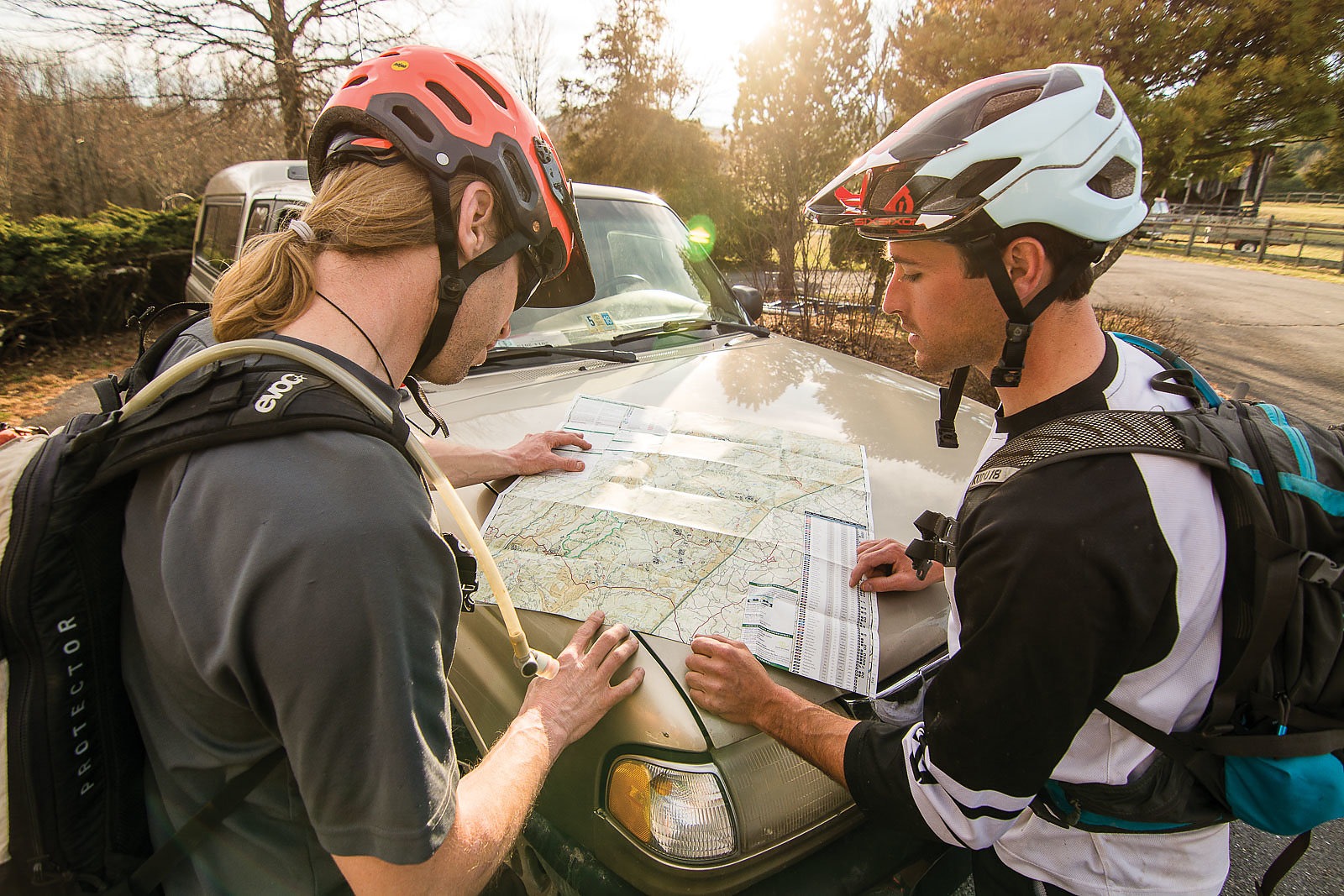
Woodstock on Wheels
After running south for some 1,000 miles, the mountains of western Virginia are where the long spine of the Appalachian breaks off into distinct ranges. To the east Blue Ridge forms a serene drape of rolling hills; to the west is a rib of mounds, punctuated by “water gaps” cut in by the area’s many rivers.
Between lies the impressive Shenandoah Valley, once regarded as the “frontier” for early settlers due to the barrier of the Blue Ridge Mountains. It’s verdant flood plain has since been home to generations of Virginians and a unique culture, born and shaped by the difficult geography.
Chris Scott is a frontiersman. In the 1980s, Scott and three other James Madison University students—Thomas Jenkins, Tim Richardson and Mike Carpenter—became friends through exploring the trails around Harrisonburg. They found rocky ridges laced with hundreds of miles of historic trails and developed what would become a lifelong connection with the terrain and the community.
From the early ‘90s, racing—from grassroot downhills to alley cat crawls—helped shape the bike culture in western Virginia, and the abundance of cross country events helped birth XC stars like Jeremiah Bishop, Sue Haywood and Gordon Wadsworth. But, as brutal as a world-class XC race, it’s nothing compared to the 100-mile sufferfests that would soon come to distinguish the area thanks to Scott and Mike Carpenter.
Like other mountain bikers during that era, Scott soon fell into the XC competition scene, eventually turning pro—which ended a few years later when he was hit by a car. Done with the pro race scene, in 1998 Scott joined Mike Carpenter to ride the Cascade 100 in Bend, OR for Carpenter’s 25th birthday. The endurance race left a mark on the two. It wasn’t the trail riding or the course that made the impression. It was how the community of riders came together, celebrating the tough event with a festival atmosphere.
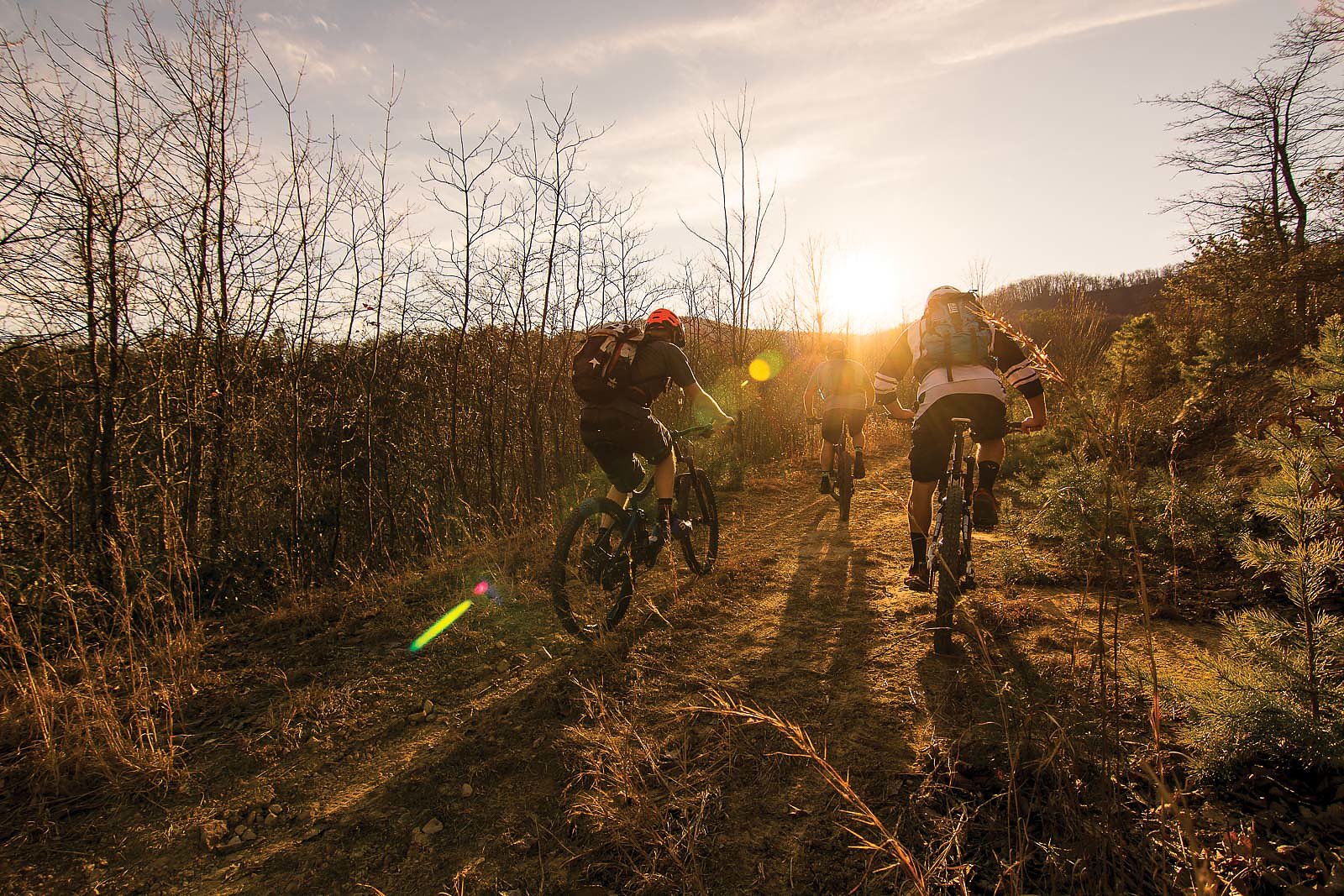
The next year they launched the Shenandoah 100, a punishing 100-mile ride that climbs and descends 12,000 feet through the rugged and rocky George Washington National Forest. A fair percentage of riders won’t even finish, yet the SM 100 is in its 18th year and reigns as one of the region’s most popular events. That’s because for most, it’s not about racing or even surviving. Like the Cascade 100, it’s about being part of the festivities.
“It’s the closest thing I can imagine to Woodstock in the ‘60s: People from diverse walks of life, all called to one place for a gathering of the tribe."
- Gordon Wadsworth
But as popular and community-driven as is the SM 100, it’s not the glory event for the region. That title goes to the Tour De Burg. Imagined by Scott and Carpenter 20 years ago as an antidote for a summer’s worth of work, the five-day stage ride showcases all the best riding in the region: Gravel grinds, raucous descents, even a road stage. It’s a competition, yes, but it’s more the western Virginia bike scene pulled into one event. As Virginia ex-pat and Fastest Singlespeeder in the World, Gordon “Quadsworth” Wadsworth, says:
“It’s the closest thing I can imagine to Woodstock in the ‘60s: People from diverse walks of life, all called to one place for a gathering of the tribe. They’re politically, socially and financially diverse, but in the end everybody has shared the experience of pitching themselves against the rugged landscape and emerging victorious to themselves and the community. It’s as if the whole realm of the human journey has been experienced in just a couple hours.”
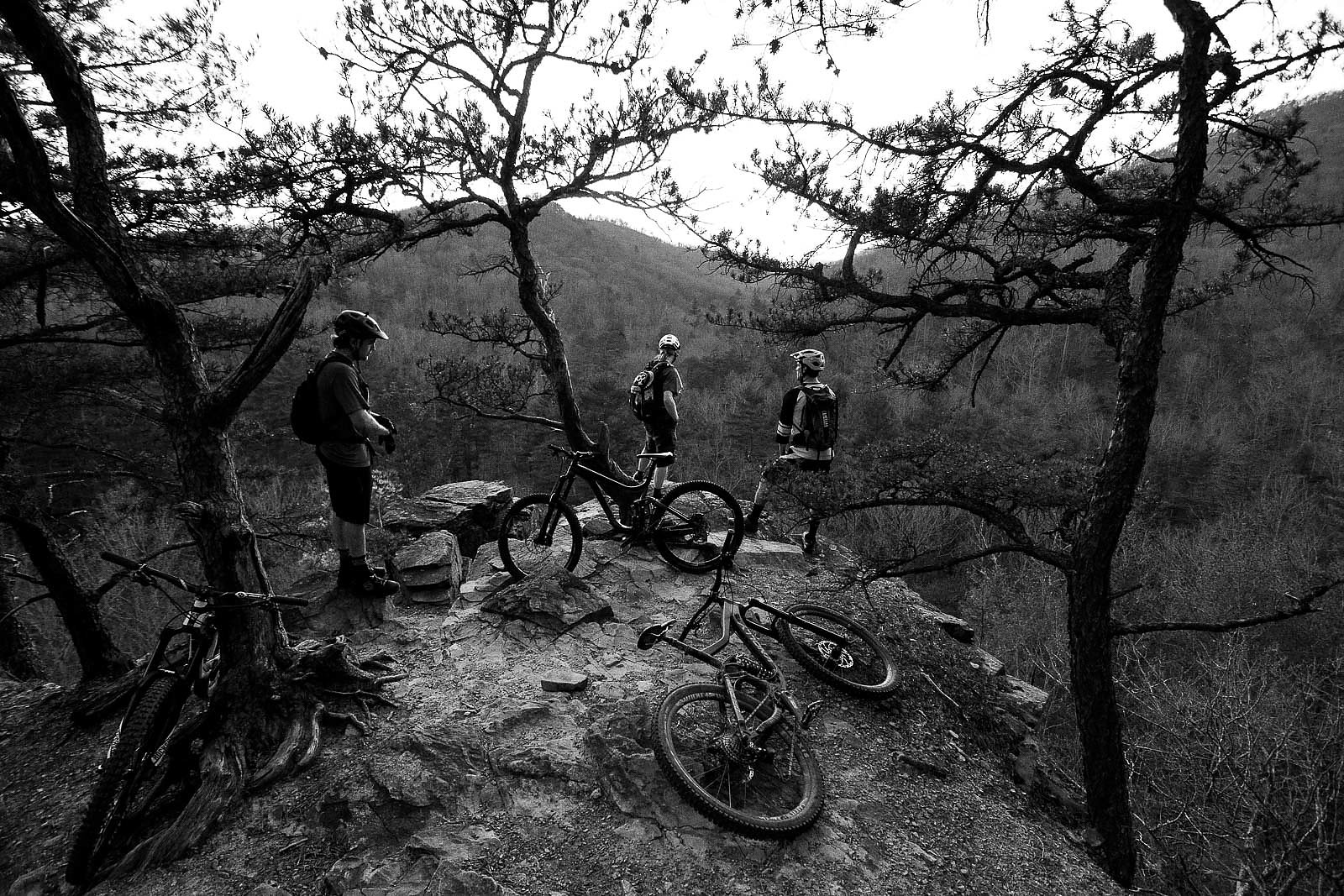
The Backcountry
Reddish Knob rises to near 4,000 feet on the Virginia/West Virginia boarder, the road to the summit spiraling up to a dirt Forest Service parking lot. As the Expedition pulls to a rest, we can make out the dramatic southern point of Massanutten Mountain to the east. The crumpled and folded mountains of West Virginia settle the view to the west. North and south nothing but mountains extend beyond view. We’re here to ride the Timber Ridge Trail, an area icon, but it’s not obvious where it starts.
“Just through the guardrail there’s a steep drop in,” says Collin Vinton, long-time local and guide with Shenandoah Bike Touring. We find it, and eye the first section of tilted rock ledges dubiously. “Just span the gaps,” Vinton says, before starting us off down the 9-mile long, 3,000-foot descent to the North River on the valley floor.
Timber Ridge rips off the top, and we rally through open scree fields and laurel-lined forests before the trail branches off onto Wolf Ridge and into a section of old-school downhill riding. From there it eases into a new, pump-track-ish segment of trail, which spills us out at another USFS parking lot. It’s full of local riders, whose bikes reveal the nature of the trails: Rims, down tubes and rear derailleurs are dinged and scratched from rumbling through the chunder. At most riding areas the route would be a crown jewel. Here it’s just nine miles of mountain-bike bliss among the area’s 500 miles of backcountry trails.
“Backcountry” is not a word typically associated with the Mid-Atlantic States. Most people reserve the revered concept for remote, rugged terrain that demands careful planning and a high level of determination to reach. But this zone, one of the East Coast’s largest expanses of protected public lands, is just a two-hour drive from over 10 million people. The federal government calls it the George Washington and Thomas Jefferson National Forests. The locals call it the Backcountry.

The two forests encompass the Blue Ridge and Allegheny Mountains, which run along the border of Virginia from Maryland to West Virginia to Kentucky to Tennessee. Together they are three times as large as the better-known Pisgah National Forest, and roughly one million acres of the 1,790,933 acres are classified as “remote” by the federal government. Long, linear, rocky-toped ridges draw the contour lines above flat-bottomed valleys; rivers notch out east-west slices. And the vastness of this unbroken forest is matched by the long distance trails that climb from the valley floors and traverse the ridges.
A trail system this big takes a lot of effort and a long time to develop, and in the case of the George Washington and Thomas Jefferson National Forests it started at with President Franklin D. Roosevelt’s Civilian Conservation Corps. Starting in 1933 and based out of Camp Roosevelt, the first CCC camp in the nation, groups of men took pick axes and shovels into the forests. The official goal was to help jobless US citizens recover from the Great Depression by building infrastructure; the resulting trails and footpaths would spark the first awakenings of the area’s spirit for backcountry adventure.
Chris Scott has, unsurprisingly, been possessed by that spirit. He saw a massive spread of potential, perfect for an equally massive, 100-mile race. Scott began to study the maps, looking for ways to link different backcountry trails, and soon he was taking friends on reconnaissance missions. Then, after numerous rides and hours of brainstorming, he had it—a long distance, singletrack route connecting all the public lands from the northern to southern Virginia borders.
The Virginia Mountain Bike Trail was the result, and the 480-mile traverse would be a proud line on any rider’s resume. For Scott, however, the completion of the route is a beginning. “The idea is to have something of Appalachian Trail for mountain bikers,” Scott says. Eventually, Scott hopes riders will complete the journey with light loads and take overnight refuge in huts along the way. “It’s really less about the trail, but rather connecting communities through the trails,” Scott says. “That, and giving them something authentic.”
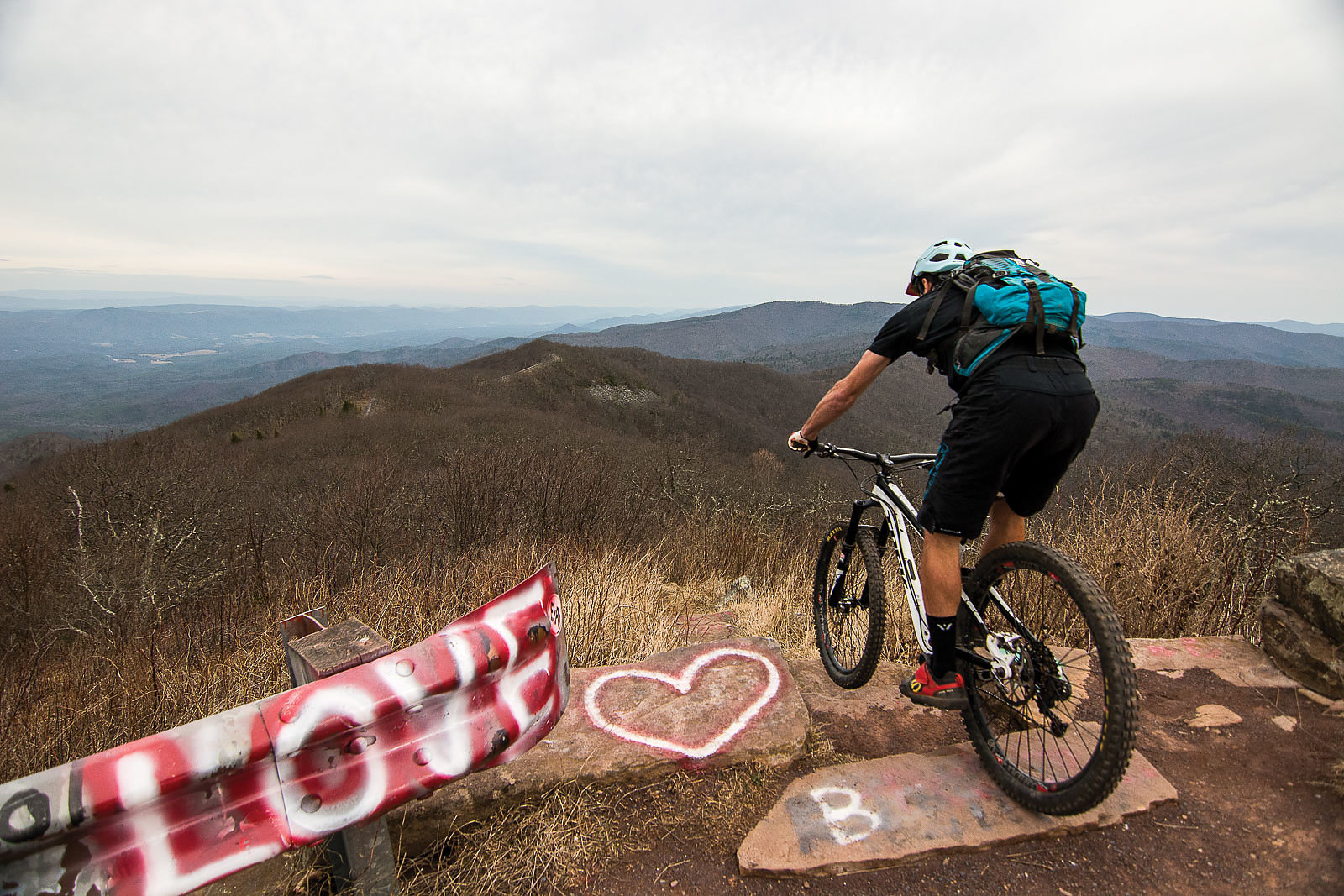
Tillman's to Narrowback
Deep backcountry traverses, however, aren’t for everyone, and on a timber cut along the western slope of Narrowback Mountain, Tillman’s Trail weaves a smooth dirt path among new growth pine. It sidehills up the ridge, replacing the old fall-line erosion gully with a smooth, bike-optimized trail to the top, from which riders can then choose several loop options. We arrive at the trail junction, Scott explains the significance of Tillman’s. “This is what we’ve been missing. We have the rugged backcountry, but we haven’t had a way to get beginner riders out to the forest.”
Tillman’s Trail would not exist without the Shenandoah Valley Bicycle Coalition, and is a dirt and stone testament to the valley community’s advocacy efforts. The SVBC traces its roots back to 1982, as the area’s original road bike club. In 1996 it merged with a local mountain bike club, and the combination of disciplines yielded a whole new strength to the SVBC. “We’re not just promoting mountain biking,” says Kyle Lawrence, the coalition’s president. “We advocate with the city, the county and the National Forest.”
Lawrence continues, tallying off an impressive list of the club’s achievements: $600,000 received in federal grants for trails, assisting with a multimillion-dollar project to connect schools in town, collaborating with the county on bike and pedestrian master plans, creating and managing the Massanutten Resorts trail permit and maintenance system, all along with assisting the USFS with their forest trail plan.
When the SVBC got wind of the timber sale on Narrowback Mountain, they began working with Forest Service to negotiate replacing the old trail and enhancing the experience on Narrowback. The resulting trails have become some of the most popular in the Harrisonburg area.
“The beauty of the trail,” adds Collin Vinton, “is that riders can sample this trail and not commit to a full day in the woods. The trail rides great in both directions, providing an out-and-back experience where riders can turn around wherever they want.”
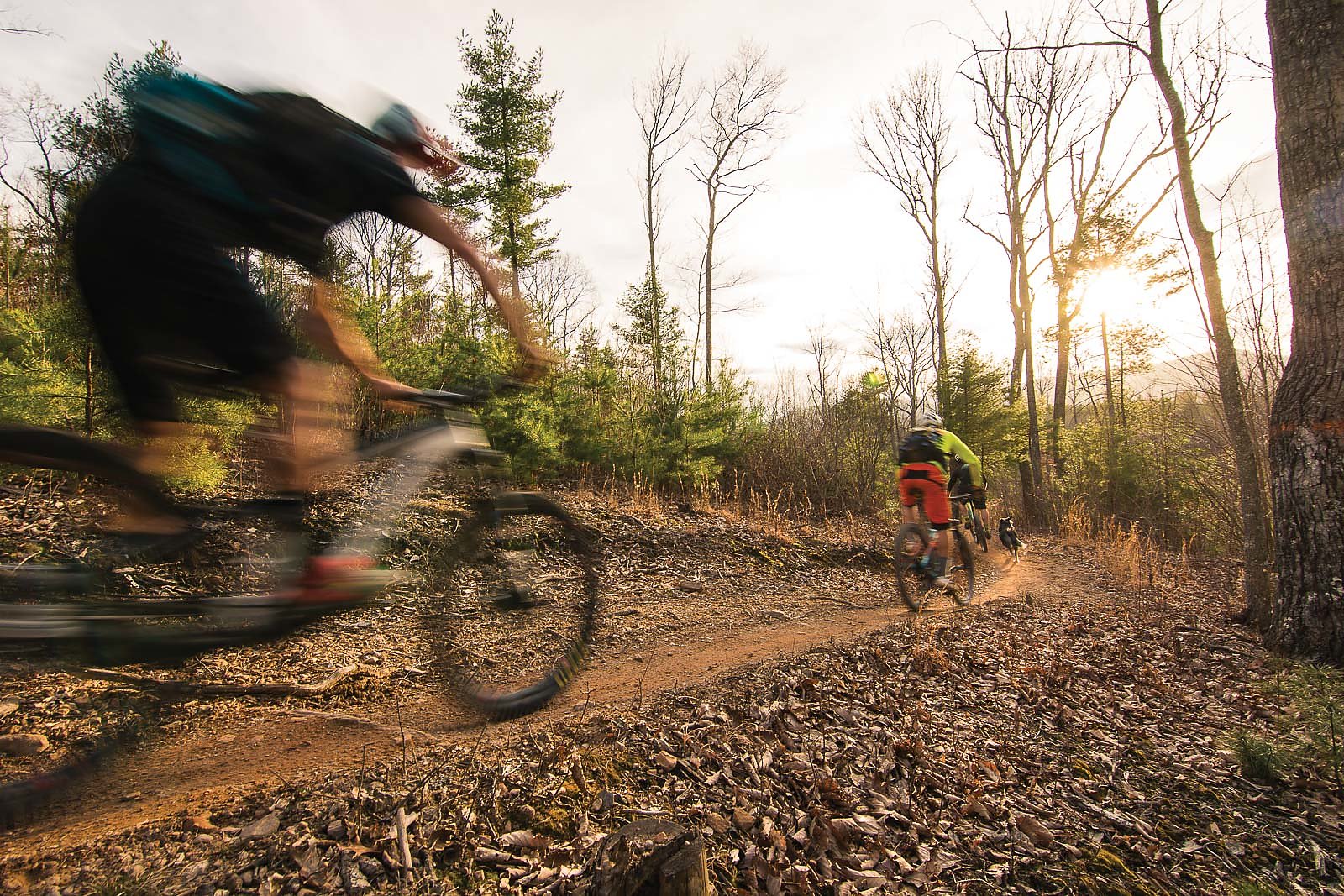
Hillendale
Modest two story houses surround Hillendale Park, not far from downtown Harrisonburg. The park’s smooth trails wind through a dense cedar forest and limestone rocks, five miles exemplifying the International Mountain Bicycling Association’s stacked loop system. It’s not a surprise, as the trail is literally in an IMBA guru’s backyard.
Walking the park with Rich Edwards is an education—both in trail construction and Edwards’s vision for the area’s future. From the succession of the forest to invasive species to the importance of dog walkers, ideas pour of Edwards like a comprehensive flood. We stop to let a family walking their dog pass. “This is it,” he says, pointing at the walkers. “This is how we know we are successful.”
Edwards’s experience as a trails specialist spans 20 years, and he’s seen first-hand the progression and evolution of trail building. “We know we’re getting it right when people are getting into the woods,” he continues. “We see people on new bikes with new gear out here riding in the rain, covered in mud, but smiling the whole time.”
We walk past a rutted corner, and rather than frustrated Edwards sees it as an opportunity: “We used to criticize that rider for ‘ruining’ the trails. Now we know they need to get fired up and educated.”
This wide-view wisdom comes from decades of work with trails and communities around the US, which eventually brought Edwards and his wife Jen to their home in Harrisonburg. Jen has also spent time involved with IMBA, as a member of their first Trail Care Crew. Fifteen years ago, the two had been on the road with the TCC, building trail and looking for a place to settle down. Then they found themselves in Harrisonburg, and their search was over. “Harrisonburg was an easy choice with so much public land out the back door,” Edwards says. “Though at the time it had no reputation of being a ‘cool’ town.”

Hip or not, cycling was already booming in the “Burg,” in all its disciplines. Downhilling, XC races, bike commuters and neighborhood kids on 24-inch wheels all breathed life into the town. But it was the people on the bikes that made the decision for Edwards. “In most places around the country, riders separate into their own groups,” Edwards says. “Here they’re all welded together. Mountain bikers, road bikers; they’re all on the same page.”

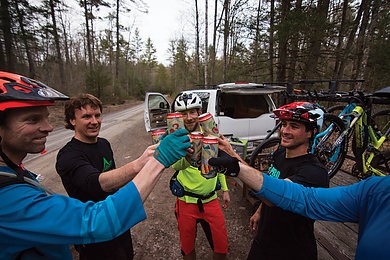
Hillendale’s newest addition to their cycling community spans 1,000 linear feet, and—in the park’s standard fashion—designed for all riders, no matter their skill level. The Rocktown Bike Park Trail is a collaboration between the City of Harrisonburg, Brad Stone’s 402 Trails, and IMBA and is a completely linear pump track jump line. The kicker is it’s a green trail. “Every roller, berm, and camelback can be rolled by a beginner rider,” Edwards says. And yet it has features to keep even experts happy, like a 20-foot berm to berm gap that Edwards points out. “I haven’t seen anyone ride this yet.”
It’s the kind of trail that you simply can’t pass up. Tim Haren and I grab our bikes and ride up for some hot laps, all the while blown away by the fact the whole thing is designated green circle. Rollable or not, the design and layout allow for huge airs and transfers, and as Haren and I rave on Edwards smiles through his beard. This is how to bring new riders into the sport: A beginner trail that showcases modern riding, is friendly and easy to access, and is an absurd amount of fun.
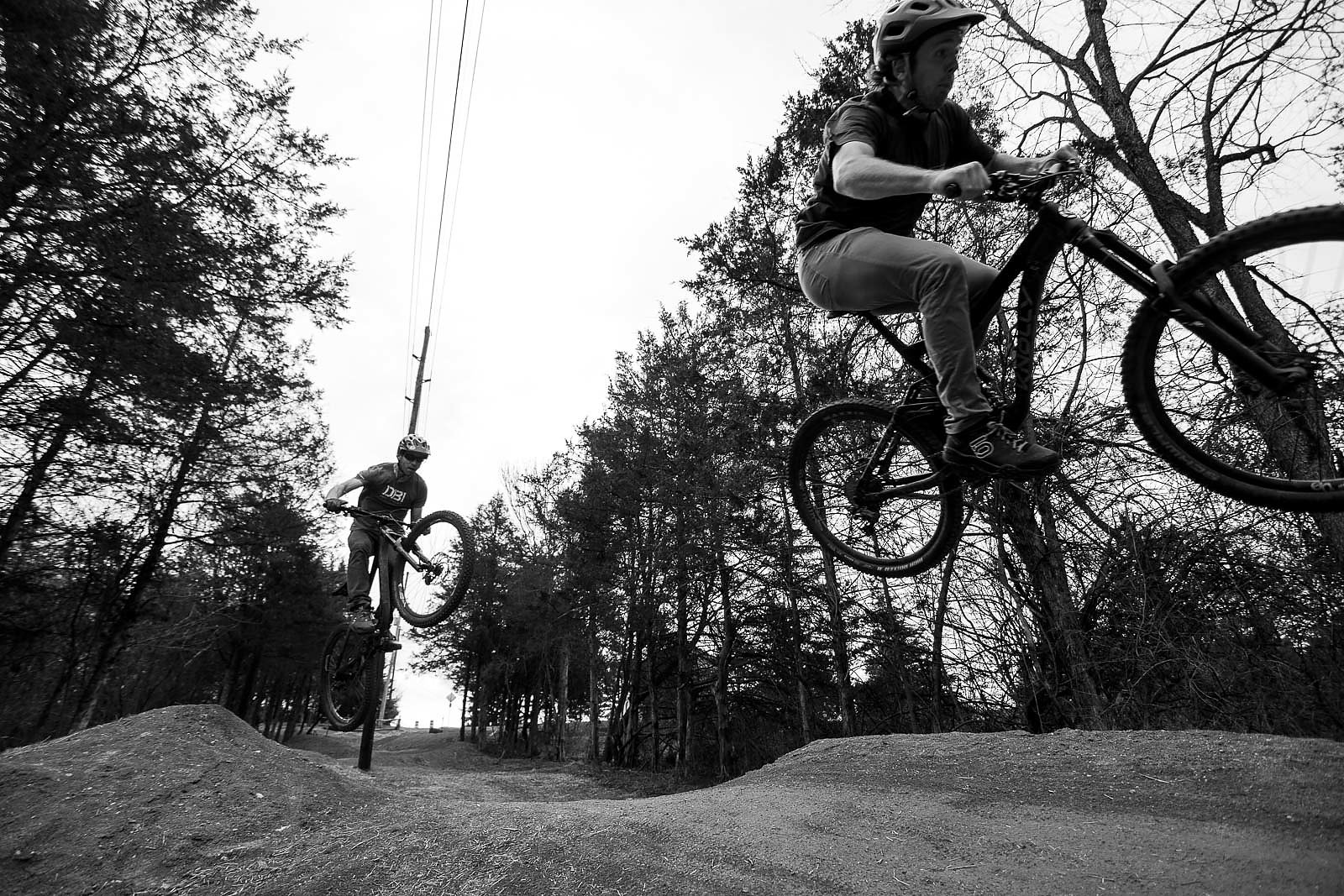
Back to Stokesville
Stokesville Lodge faces Lookout Mountain, a small hump in front of the massive hulk of Shenandoah Mountain. The lodge’s two-story A-Frame points up, as if to inspire people to look higher, dream bigger. At night, the golden glow from the front windows punctuates the starry sky.
Inside, Chris Scott is watching a Youtube video on how to fix the washing machine. A small crew of locals have gathered after riding Tillman’s Trail, and Jeremy Wimpy, the man who helped us with the tenuous turnaround situation early, sits across the kitchen island and chows on some leftover pasta. Wimpy, Scott, and Edwards have spent the day planning the soon-to-be-built trail system for the lodge, a network that will (hopefully) connect to the National Forest out the window. From the forest, it will continue into “The Backcountry” and its endless goods.
The Stokesville Lodge isn’t just the existential center of the Shenandoah bike community. Scott and Carpenter used its campground for the SM 100, and in the years since has become an integral part of the culture surrounding their races. So when the lodge went up for sale a few years ago, Scott challenged the community to pool their resources and purchase Stokesville. It was a battle cry not just to buy into the property, but to believe in the future of the community. “We circled the wagons,” Scott says. “And we had 40 investors immediately.”

Friends bought shares, and Scott put down everything he owned to borrow $600,000. Fully committed, Scott was able to buy the lodge, officially making it the hub of the Shenandoah bike culture. And he has big plans. “We’re tied into the Forest Service land, and so we need to integrate our trails,” he says. “From there we’ll have trail building schools, kids camps, and ideally we’ll become a ride center.”
These dreams are typical of both Scott and the Shenandoah bike community in general. Every step here, whether it’s an underground race or the new trail in the mid-city park, enhances and encompasses the entire community, growing a culture as original and unique as the earliest settlers. Because in the Shenandoah, the best kinds of secrets are those you can share with everyone else.
![“Brett Rheeder’s front flip off the start drop at Crankworx in 2019 was sure impressive but also a lead up to a first-ever windshield wiper in competition,” said photographer Paris Gore. “Although Emil [Johansson] took the win, Brett was on a roll of a year and took the overall FMB World Championship win. I just remember at the time some of these tricks were still so new to competition—it was mind-blowing to witness.” Photo: Paris Gore | 2019](https://freehub.com/sites/freehub/files/styles/grid_teaser/public/articles/Decades_in_the_Making_Opener.jpg)
